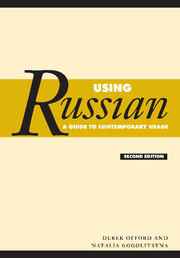Book contents
- Frontmatter
- Contents
- Preface to the first edition
- Preface to the second edition
- Acknowledgements
- Sources
- Note on transcription, stress marks and transliteration
- Glossary of linguistic terms
- List of abbreviations
- 1 Varieties of language and register
- 2 Passages illustrating register
- 3 Problems of meaning: Russian words
- 4 Problems of translation from English into Russian
- 5 Vocabulary and idiom
- 6 Language and everyday life
- 7 Verbal etiquette
- 8 Word-formation
- 9 Inflection
- 10 Prepositions
- 11 Syntax
- 12 Stress
- Index of Russian words, phrases and affixes
- General index
4 - Problems of translation from English into Russian
Published online by Cambridge University Press: 05 June 2012
- Frontmatter
- Contents
- Preface to the first edition
- Preface to the second edition
- Acknowledgements
- Sources
- Note on transcription, stress marks and transliteration
- Glossary of linguistic terms
- List of abbreviations
- 1 Varieties of language and register
- 2 Passages illustrating register
- 3 Problems of meaning: Russian words
- 4 Problems of translation from English into Russian
- 5 Vocabulary and idiom
- 6 Language and everyday life
- 7 Verbal etiquette
- 8 Word-formation
- 9 Inflection
- 10 Prepositions
- 11 Syntax
- 12 Stress
- Index of Russian words, phrases and affixes
- General index
Summary
English words difficult to render in Russian
This section lists in alphabetical order some of the more common English words which give difficulty for students learning Russian and defines some of the Russian equivalents they may have. The list is intended to encourage the student to think about the precise meaning of the English word in a given context and to consider which of the various possible Russian renderings is appropriate in that context. The lists of Russian equivalents for the English words are not intended to include all possible translations of the English word, merely to draw attention to the ways in which Russian deals with the main fields of meaning which the English word may have. In each entry the Russian word/words which render the meaning of the English word that seems most common or fundamental is/are given first.
Rendering of English prepositions is dealt with separately in 10.4.
English has many phrasal verbs (e.g. to hold back, hold on, hold up) in which the precise meaning of the verb is clarified by the following preposition. Translation of phrasal verbs is not considered here except in a very small number of cases. It should be noted that in many cases the function of the English preposition is fulfilled in Russian by a verbal prefix (see 8.3), as well as by a following preposition.
- Type
- Chapter
- Information
- Using RussianA Guide to Contemporary Usage, pp. 98 - 162Publisher: Cambridge University PressPrint publication year: 2005



